
The HEIM Layer One Blockchain is designed to make cryptocurrency custody safer and easier. It uses a smart system called dual-key custody, where two separate keys, one for managing and one for everyday use, give extra protection compared to regular wallets. This setup keeps your crypto more secure, helps prevent tampering, and lets you set custom spending limits, all without making it harder to use.
Cryptocurrency wallets generally fall into two main categories: hot wallets and cold wallets.
Hot wallets are connected to the internet, making them convenient for everyday transactions but more vulnerable to hacks and phishing attacks. Cold wallets, on the other hand, are kept offline, offering strong protection against online threats but offering weaker user friendliness. Users often face a trade-off between security and convenience when choosing how to store their digital assets.
With self-custody, individuals manage their cryptocurrencies on their own instead of relying on third-party custodians, such as crypto exchanges. While self-custody gives users full control over their assets, it comes with its own risks.
If a user loses their private key or recovery phrase, their funds may be permanently inaccessible. Additionally, most wallets offer a single point of control, which creates vulnerabilities, especially in cases of theft, phishing, or user error. The balance between full ownership and security remains a major challenge in crypto custody.
To address the limitations of traditional self-custody, dual-key custody introduces a more secure and flexible framework. In this system, two separate keys are used: an admin key and a worker key.
The admin key provides high-level control over wallet settings, such as setting spending limits or revoking access, while the worker key is used for day-to-day transactions. By splitting responsibilities between the two keys, this model adds an extra layer of security, reducing the risk of total asset loss or unauthorized access. If one key is compromised, the other can still provide recovery or control options, making it a more robust solution for individuals and institutions alike.
In an impressive move, HEIM adopted the dual-key concept to provide a user-friendly custody solution without sacrificing security. They are aiming to address an issue in the space that keeps less tech-savvy investors and enthusiasts from entering the space.
HEIM creates a layered account model, separating the admin from the regular user. Admin is responsible for setting rules, such as defining spending limits or approved recipients, while the worker role carries out actions based on those predefined settings. By isolating the admin and worker accounts, the system significantly reduces the risk of theft or accidental loss. Additionally, because no single party, including HEIM, has access to both keys simultaneously, the system avoids a single point of failure, enhancing overall security and resilience.
The dual-key custody model implemented by HEIM integrates two independent keys with distinct responsibilities, along with a structured consensus process and a clear separation between the signature and consensus networks.
To enable secure cooperation between the two keys, HEIM uses Paillier encryption, a cryptographic technique that allows both devices to co-sign transactions without exposing any sensitive information. Despite the complexity behind the scenes, the experience remains seamless for users.
To ensure speed and efficiency, HEIM employs an enhanced version of the SEI consensus mechanism, which accelerates transaction finality. Unlike traditional methods that require three consensus phases, HEIM often completes validation in just two, significantly reducing latency and ensuring that transactions are confirmed within fractions of a second.
The protocol is maintained by a network of validator nodes, which are responsible for verifying transactions, proposing new blocks, and maintaining the blockchain’s security. These validators are supported by specialized MPC nodes (multi-party computation nodes), which handle sensitive cryptographic operations.
The system also implements a Proof-of-Stake incentive model. Validator nodes must stake the native HEIM token to participate, earning rewards for honest behavior. Any dishonest attempts result in slashing penalties, which help maintain trust, security, and fairness across the network.
In an impressive move, HEIM adopted the dual-key concept to provide a user-friendly custody solution without sacrificing security. They are aiming to address an issue in the space that keeps less tech-savvy investors and enthusiasts from entering the space.
While claiming to be the first solution addressing the Custody Trilemma, HEIM introduces a model that seeks to balance security, usability, and decentralization, three goals traditionally seen as difficult to achieve simultaneously in crypto asset custody.
The HEIM protocol is still under active development. While the conceptual architecture presents a strong foundation, its real-world performance, security, and user adoption will ultimately determine its success.
Well, seems we have to wait and see!